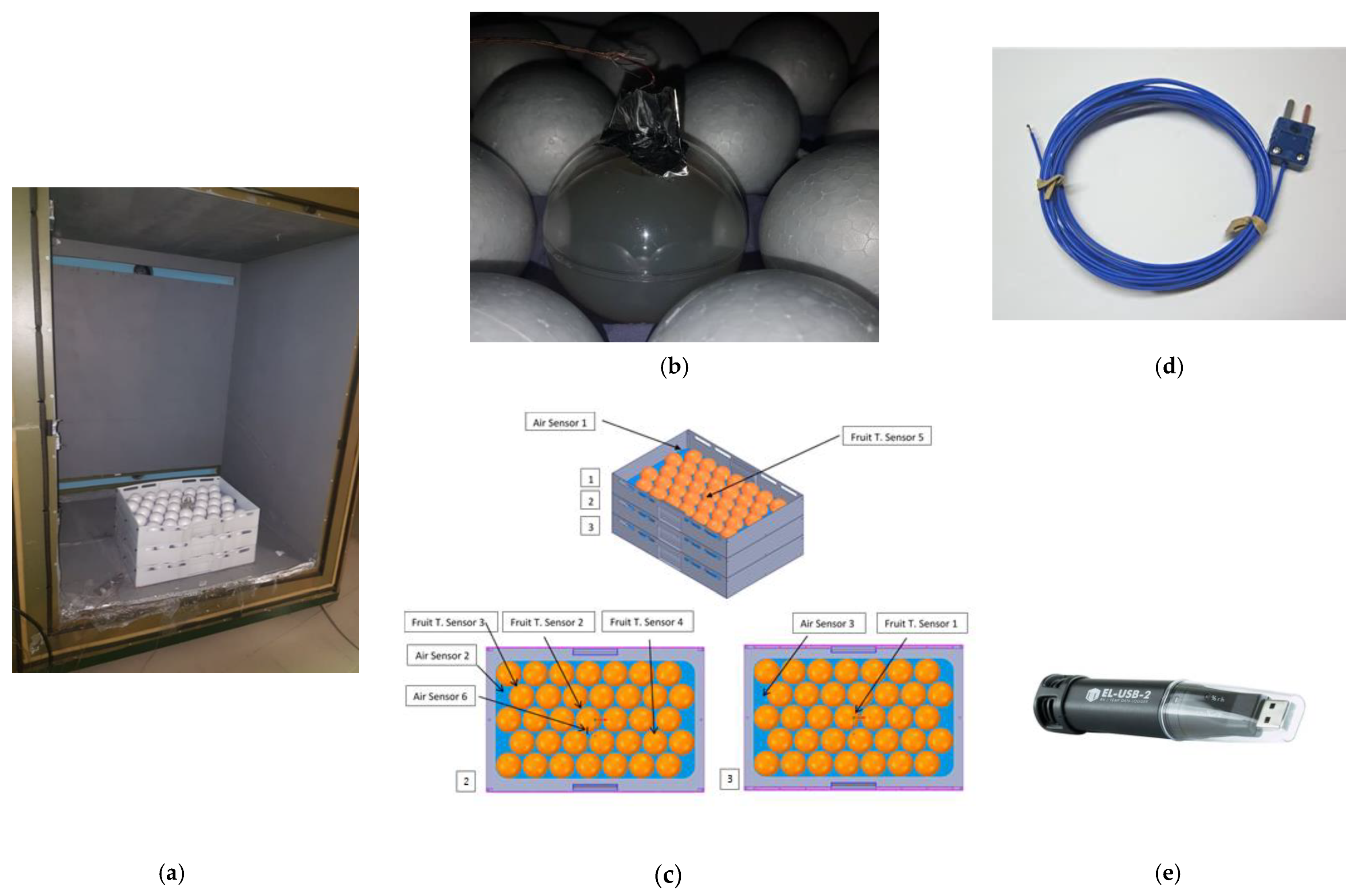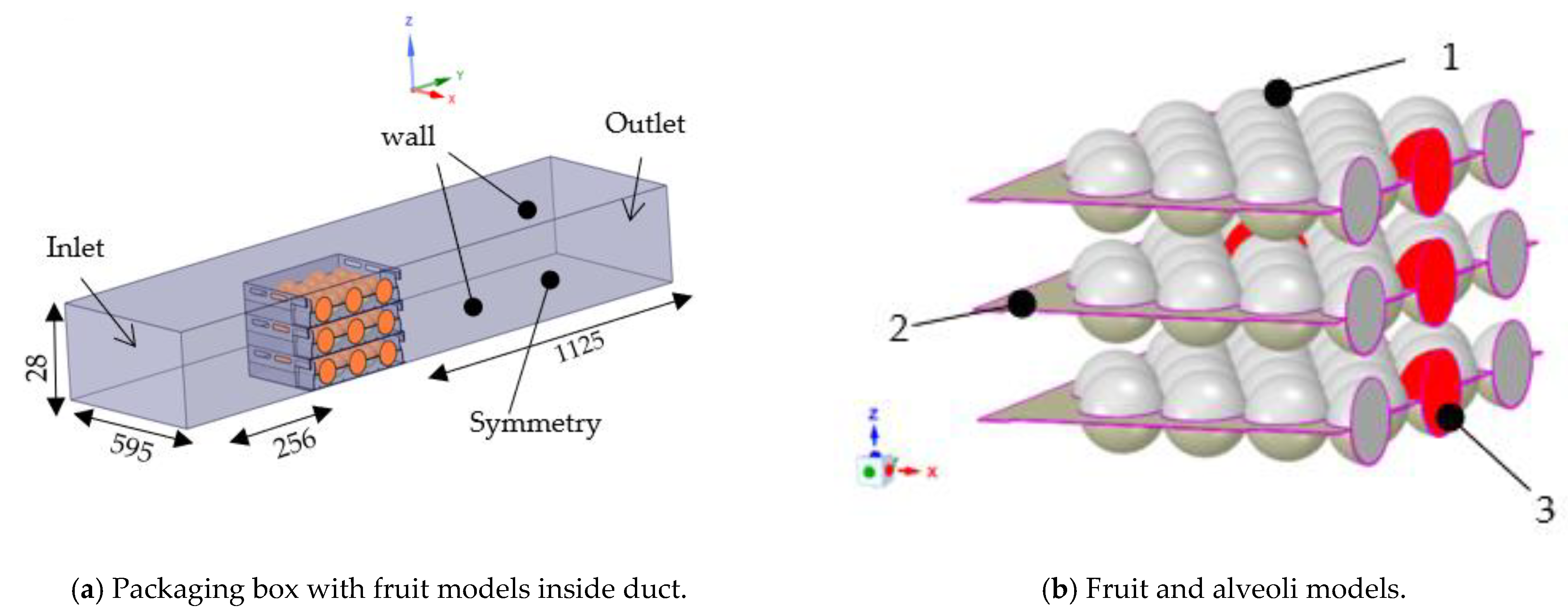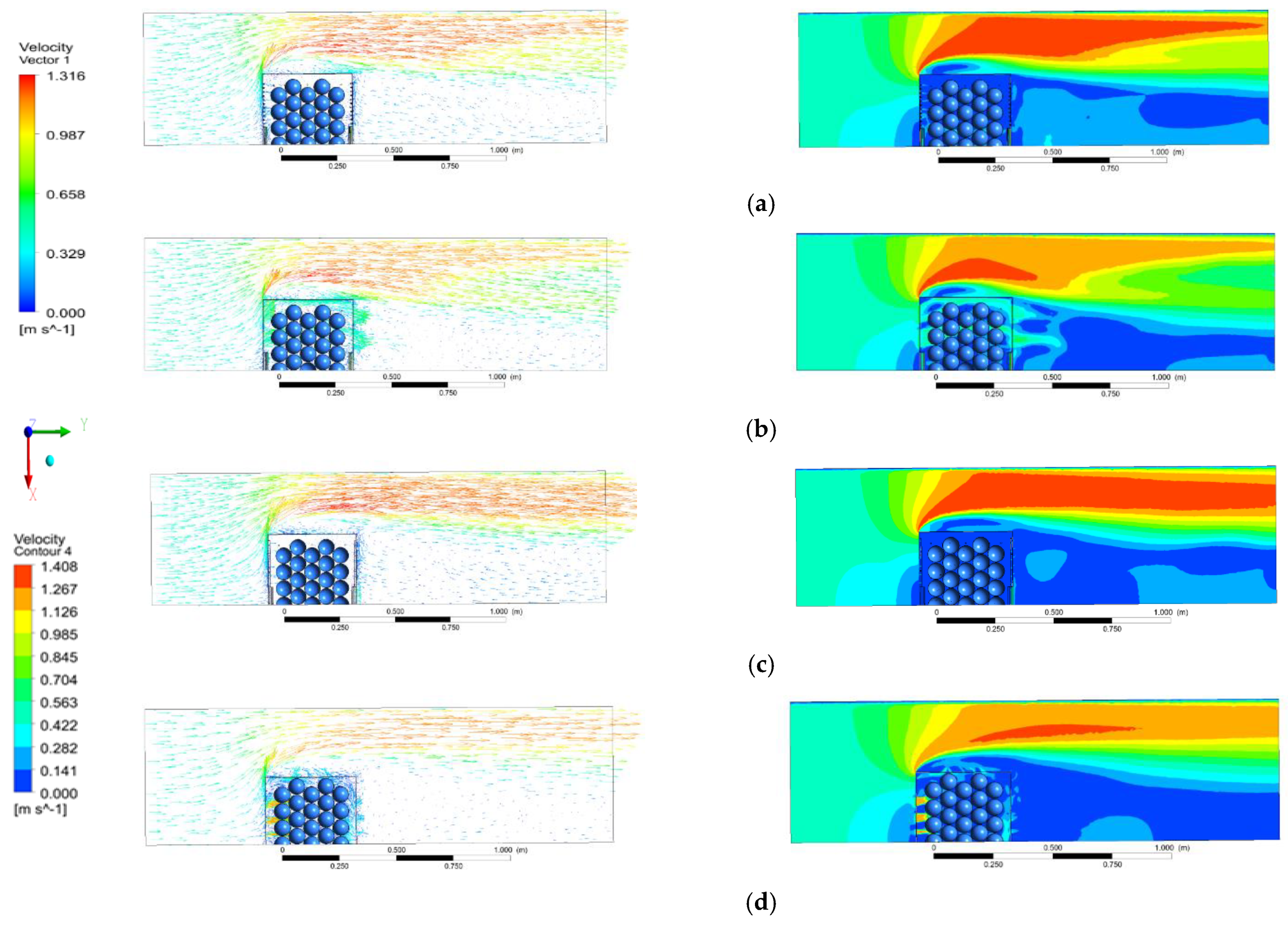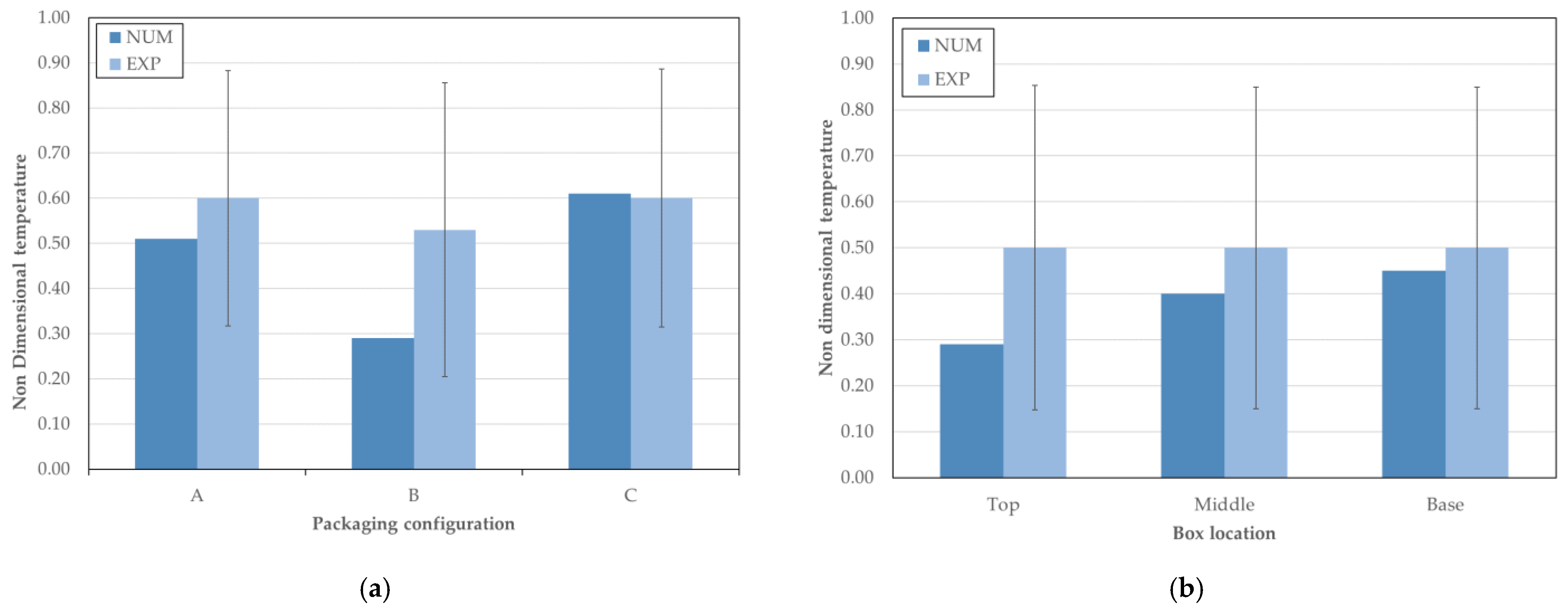CFD Modelling of the Thermal Performance of Fruit Packaging Boxes—Influence of Vent-Holes Design
Abstract
:1. Introduction
2. Materials and Methods
2.1. Physical Model
2.2. Experimental Procedure
2.3. Computational Model
2.4. Mathematical Model
2.5. Simulation Setup
3. Analysis and Discussion of Results
Temperature Distribution within Different Packaging Box Configuration
4. Conclusions
Author Contributions
Funding
Institutional Review Board Statement
Informed Consent Statement
Data Availability Statement
Acknowledgments
Conflicts of Interest
References
- Defraeye, T.; Cronjé, P.; Berry, T.; Opara, U.L.; East, A.; Hertog, M.; Verboven, P.; Nicolai, B. Towards integrated performance evaluation of future packaging for fresh produce in the cold chain. Trends Food Sci. Technol. 2015, 44, 201–225. [Google Scholar] [CrossRef]
- Pathare, P.B.; Opara, U.L.; Vigneault, C.; Delele, M.A.; Al-Said, F.A.-J. Design of packaging vents for cooling fresh horticultural produce. Food Bioprocess. Technol. 2012, 5, 2031–2045. [Google Scholar] [CrossRef]
- Wu, W.; Defraeye, T. Identifying heterogeneities in cooling and quality evolution for a pallet of packed fresh fruit by using virtual cold chains. Appl. Therm. Eng. 2018, 133, 407–417. [Google Scholar] [CrossRef]
- Zhao, C.-J.; Han, J.-H.; Yang, X.-T.; Qian, J.-P.; Fan, B.-L. A review of computational fluid dynamics for forced-air cooling process. Appl. Energy 2016, 168, 314–331. [Google Scholar] [CrossRef]
- Han, J.-H.; Zhao, C.-J.; Qian, J.-P.; Ruiz-Garcia, L.; Zhang, X. Numerical modeling of forced-air cooling of palletized apple: Integral evaluation of cooling efficiency. Int. J. Refrig. 2018, 89, 131–141. [Google Scholar] [CrossRef]
- Han, J.-H.; Badia-Melis, R.; Yang, X.-T.; Ruiz-Garcia, L.; Qian, J.-P.; Zhao, C.-J. CFD simulation of airflow and heat transfer during forced-air precooling of apples. J. Food Process. Eng. 2017, 40, e12390. [Google Scholar] [CrossRef]
- Han, J.-H.; Qian, J.-P.; Zhao, C.-J.; Yang, X.-T.; Fan, B.-L. Mathematical modelling of cooling efficiency of ventilated packaging: Integral performance evaluation. Int. J. Heat Mass Transf. 2017, 111, 386–397. [Google Scholar] [CrossRef]
- Defraeye, T.; Lambrecht, R.; Tsige, A.A.; Delele, M.A.; Opara, U.L.; Cronjé, P.; Verboven, P.; Nicolai, B. Forced-convective cooling of citrus fruit: Package design. J. Food Eng. 2013, 118, 8–18. [Google Scholar] [CrossRef] [Green Version]
- Wu, W.; Cronjé, P.; Nicolai, B.; Verboven, P.; Opara, U.L.; Defraeye, T. Virtual cold chain method to model the postharvest temperature history and quality evolution of fresh fruit–A case study for citrus fruit packed in a single carton. Comput. Electron. Agric. 2018, 144, 199–208. [Google Scholar] [CrossRef]
- Berry, T.M.; Defraeye, T.; Nicolai, B.; Opara, U.L. Multiparameter analysis of cooling efficiency of ventilated fruit cartons using CFD: Impact of vent hole design and internal packaging. Food Bioprocess. Technol. 2016, 9, 1481–1493. [Google Scholar] [CrossRef]
- Delele, M.A.; Ngcobo, M.E.K.; Getahun, S.T.; Chen, L.; Mellmann, J.; Opara, U.L. Studying airflow and heat transfer characteristics of a horticultural produce packaging system using a 3-D CFD model. Part I: Model development and validation. Postharvest Biol. Technol. 2013, 86, 536–545. [Google Scholar] [CrossRef]
- Mukama, M.; Ambaw, A.; Opara, U.L. Advances in design and performance evaluation of fresh fruit ventilated distribution packaging: A review. Food Packag. Shelf Life 2020, 24, 100472. [Google Scholar] [CrossRef]
- O’Sullivan, J.L.; Ferrua, M.J.; Love, R.; Verboven, P.; Nicolaï, B.; East, A. Forced-air cooling of polylined horticultural produce: Optimal cooling conditions and package design. Postharvest Biol. Technol. 2017, 126, 67–75. [Google Scholar] [CrossRef]
- Getahun, S.; Ambaw, A.; Delele, M.A.; Meyer, C.J.; Opara, U.L. Analysis of airflow and heat transfer inside fruit packed refrigerated shipping container: Part I–Model development and validation. J. Food Eng. 2017, 203, 58–68. [Google Scholar] [CrossRef]
- Han, J.W.; Zhao, C.J.; Yang, X.T.; Qian, J.P.; Fan, B.L. Computational modeling of airflow and heat transfer in a vented box during cooling: Optimal package design. Appl. Therm. Eng. 2015, 91, 883–893. [Google Scholar] [CrossRef]
- Gruyters, W.; Defraeye, T.; Verboven, P.; Berry, T.; Ambaw, A.; Opara, U.L.; Nicolai, B. Reusable boxes for a beneficial apple cold chain: A precooling analysis. Int. J. Refrig. 2019, 106, 338–349. [Google Scholar] [CrossRef]
- Leitão, F.; Madhan, S.K.; Silva, P.D.; Gaspar, P.D. Experimental testing of the thermal response of different food alveoli solutions for packaging boxes. In Proceedings of the World Congress on Engineering (WCE 2021), London, UK, 7–9 July 2021. [Google Scholar]
- Madham, S.K.; Leitão, F.; Silva, P.D.; Gaspar, P.D.; Duarte, D. Experimental tests of the thermal behaviour of new sustainable bio-packaging food boxes. Procedia Environ. Sci. Eng. Manag. 2021, 8, 215–223. [Google Scholar]
- Curto, J.; Ilangovan, A.; Leitão, F.; Gaspar, P.D.; Silva, P.D.; Alves, N. Impact on cooling behaviour of vent-holes design on fruit packaging boxes: Experimental and numerical study. In Proceedings of the 14th World Congress in Computational Mechanics (WCCM) ECCOMAS Congress 2020, Paris, France, 11–15 January 2021. [Google Scholar]
- Leitão, F.; Silva, P.D.; Gaspar, P.D.; Pires, L.C.; Gonçalves, A.R.; Duarte, D. Experimental study of thermal performance of different fruit packaging box designs. Energies 2021, 14, 3588. [Google Scholar] [CrossRef]
- Bergman, T.L.; Lavine, A.S.; Incropera, F.P.; DeWitt, D.P. Fundamentals of Heat and Mass Transfer, 8th ed.; John Wiley and Sons Inc.: Hoboken, NJ, USA, 2017. [Google Scholar]
- Zhang, M.; Che, Z.; Chen, J.; Zhao, H.; Yang, L.; Zhong, Z.; Lu, J. Experimental determination of thermal conductivity of water-agar gel at different concentrations and temperatures. J. Chem. Eng. Data 2011, 56, 859–864. [Google Scholar] [CrossRef]
- Defraeye, T.; Blocken, B.; Carmeliet, J. CFD analysis of convective heat transfer at the surfaces of a cube immersed in a turbulent boundary layer. Int. J. Heat Mass Transf. 2010, 53, 297–308. [Google Scholar] [CrossRef] [Green Version]
- Defraeye, T.; Verboven, P.; Nicolai, B. CFD modelling of flow and scalar exchange of spherical food products: Turbulence and boundary-layer modelling. J. Food Eng. 2013, 114, 495–504. [Google Scholar] [CrossRef] [Green Version]
- Ambaw, A.; Bessemans, N.; Gruyters, W.; Gwanpua, S.G.; Schenk, A.; De Roeck, A.; Nicolai, B.M. Analysis of the spatiotemporal temperature fluctuations inside an apple cool store in response to energy use concerns. Int. J. Refrig. 2016, 66, 156–168. [Google Scholar] [CrossRef] [Green Version]
- Dehghannya, J.; Ngadi, M.; Vigneault, C. Mathematical modeling of airflow and heat transfer during forced convection cooling of produce considering various package vent areas. Food Control 2011, 22, 1393–1399. [Google Scholar] [CrossRef]
- Malekjani, N.; Jafari, S.M. Simulation of food drying processes by Computational Fluid Dynamics (CFD); recent advances and approaches. Trends Food Sci. Technol. 2018, 78, 206–223. [Google Scholar] [CrossRef]
- Ilangovan, A.; Gaspar, P.D.; Silva, P.D.; Duarte, D. A parametric study and performance evaluation of the different vent hole configuration for fruit packaging using Compu-tational Fluid Dynamics. In Proceedings of the 6th IIR International Conference on Sustainability and the Cold Chain (ICCC 2020), Nantes, France, 26–28 August 2020; pp. 508–515. [Google Scholar]
- Nanga, R.; Curto, J.; Gaspar, P.D.; Silva, P.D. Numerical parametric study of the influence of the arrangement of fruit packaging boxes in the fluid flow and heat transfer. In Proceedings of the III Environmental Innovations: Advances in Engineering, Technology and Management (EIAETM Conference), Online Conference, 7 September–1 October 2021. [Google Scholar]
- Ilangovan, A.; Gaspar, P.D.; Silva, P.D.; Gonçalves, A.R.; Sampaio, A.M.; Pontes, A.J.; Alves, N. CFD parametric study of the thermal performance of different fruit packaging box designs. In Proceedings of the AIP Conference Proceedings, 15th International Symposium on Numerical Analysis of Fluid Flows, Heat and Mass Transfer–Numerical Fluids 2020 (ICNAAM 2020), Rhodes, Greece, 17–23 September 2020. [Google Scholar]
- O’Sullivan, J.; Ferrua, M.J.; Love, R.; Verboven, P.; Nicolaï, B.; East, A. Modelling the forced-air cooling mechanisms and performance of polylined horticultural produce. Postharvest Biol. Technol. 2016, 120, 23–35. [Google Scholar] [CrossRef] [Green Version]
- Ilangovan, A.; Silva, P.D.; Gaspar, P.D. Airflow and thermal behavior within peaches packaging box using Computational Fluid Dynamics—A preliminary study. KnE Eng. 2020, 5, 222–231. [Google Scholar] [CrossRef]
- Badia-Melis, R.; Mc Carthy, U.; Ruiz-Garcia, L.; Garcia-Hierro, J.; Robla Villalba, J.I. New trends in cold chain monitoring applications-A review. Food Control 2018, 86, 170–182. [Google Scholar] [CrossRef]









| Physical Parameters | Fruit Simulator | Polystyrene | Alveoli Tray | Packaging Box Polypropylene |
|---|---|---|---|---|
| Density (kg/m3) | 1000 | 16 | 930 | 800 |
| Thermal conductivity (W/m·K) | 0.550 | 0.040 | 0.180 | 0.150 |
| Specific heat capacity (J/kg·K) | 4.198 | 1.210 | 1.340 | 1.200 |
| Models | Fruit Simulator | Polystyrene Balls | Alveoli | Packaging Box |
|---|---|---|---|---|
| A | 279.9 | 278.2 | 278.3 | 278.1 |
| B | 278.9 | 278.1 | 278.1 | 278.0 |
| C | 281.0 | 278.4 | 278.5 | 278.2 |
| R | 279.2 | 278.0 | 278.1 | 278.0 |
Publisher’s Note: MDPI stays neutral with regard to jurisdictional claims in published maps and institutional affiliations. |
© 2021 by the authors. Licensee MDPI, Basel, Switzerland. This article is an open access article distributed under the terms and conditions of the Creative Commons Attribution (CC BY) license (https://creativecommons.org/licenses/by/4.0/).
Share and Cite
Ilangovan, A.; Curto, J.; Gaspar, P.D.; Silva, P.D.; Alves, N. CFD Modelling of the Thermal Performance of Fruit Packaging Boxes—Influence of Vent-Holes Design. Energies 2021, 14, 7990. https://doi.org/10.3390/en14237990
Ilangovan A, Curto J, Gaspar PD, Silva PD, Alves N. CFD Modelling of the Thermal Performance of Fruit Packaging Boxes—Influence of Vent-Holes Design. Energies. 2021; 14(23):7990. https://doi.org/10.3390/en14237990
Chicago/Turabian StyleIlangovan, Adhiyaman, João Curto, Pedro D. Gaspar, Pedro D. Silva, and Nanci Alves. 2021. "CFD Modelling of the Thermal Performance of Fruit Packaging Boxes—Influence of Vent-Holes Design" Energies 14, no. 23: 7990. https://doi.org/10.3390/en14237990







